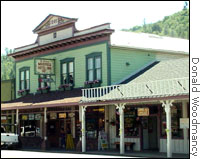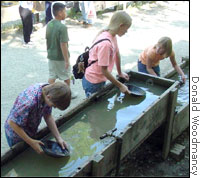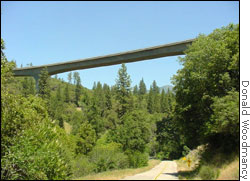The Gold Rush Trail: California Highway 49
MOTHER LODE COUNTRY, CALIFORNIA— Gold! The cry went up from Sutter's Mill and brought tens of thousands stampeding into California from the four corners of the world. These '49ers established hundreds of instant mining towns along the western foothills of the Sierra Nevada. Many of these historic and picturesque towns still exist, linked by California Highway 49, The Gold Rush Trail. I joined the Trail at its southern end, in Oakhurst. In four days, I made it almost all the way to its northern terminus in Vinton, 326 road miles and a century-and-a-half away. In addition to being packed with history, CA-49 delivers on the scenery front, too. Throughout its length, it twists and climbs past panoramic vistas. Rocky meadows, oaks, and piñon pines accent the hills, while tall firs and redwoods stud higher slopes. Delicate, multi-hued wildflowers splash color across fields and hillsides in spring and summer. Dozens of lakes, rivers, and streams provide counterpoint to stunning geologic wonders. I made brief stops in many old mining towns along the Trail. They retain their early architecture and charm -living reminders of the rich history of the Mother Lode. Coulterville, Sonora, Angels Camp, Jackson, Nevada City, and Downieville all retain their 1850's flavor and are worth visits, especially if you like antique stores housed in vintage buildings. The California State Mining Museum in Mariposa offers an excellent collection of artifacts and explanations.
I stayed overnight in Columbia, one of the best-preserved old towns in Mother Lode country. The whole town is a living history museum, with docents dressed in period costumes. Activities include panning for gold and riding in a stagecoach . Another great stop was the Marshall Gold Discovery State Historic Park at Sutter's Mill near Coloma. You can tour the mill and stand on the spot where James Marshall picked up those first tiny flecks that started the Gold Rush. Hangtown, which has since been renamed Placerville, is where the famous "Hangtown Fry" was invented and is still featured on many local menus. An omelet with cheese, bacon, onions, and oysters, the first Hangtown Fry was whipped up during the height of the Gold Rush when a suddenly successful miner demanded, "the most expensive food you've got!" Railtown 1897 in Jamestown is another living history museum and has been featured in over 200 movies and TV shows. You can enjoy their museum (open daily) and weekend train rides powered by steam locomotives. Side trips off CA-49 abound. Just east of Angels Camp in Murphys, where the largest crystalline gold nugget in the world is on display - at 44 pounds, it's worth about $3.5 million. The town of Rough and Ready, whose evocative name offers some great photo opportunities, is just west of Grass Valley.
Almost all of CA-49 is a well-maintained, two-lane roadway, but if you are impatient or in a hurry, this is not the route for you. Logging trucks and other large vehicles often slow traffic, and every town along the route has low speed limits. Think in terms of moseying, and you'll be in the right frame of mind. It would be easy to spend far longer than four days cruising the Gold Rush Trail. This is exactly what makes the route wonderful, and it makes a great trip for kids. Interesting places to stop are never far apart, and the drama of living history appeals to all ages. There's no end to the nuggets you'll discover in California's Mother Lode Country. —Donald Woodmancy
|



